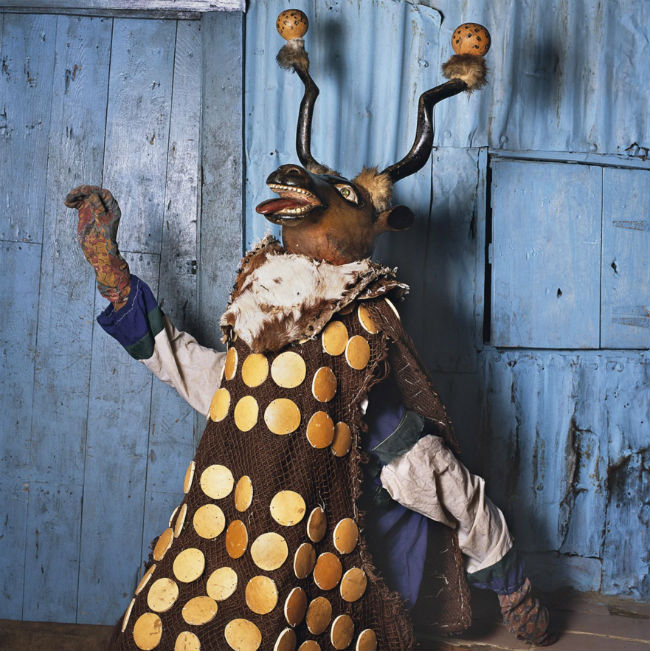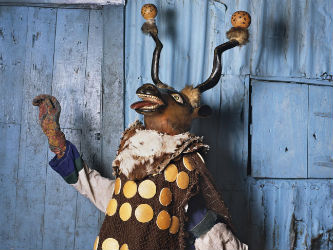
BOCA RATON, Fla. – Museum-goers will be spellbound by the transformative power of the African masquerade, as the Boca Raton Museum of Art presents “Phyllis Galembo: Maske.” Her striking photographic series of contemporary mask rituals has drawn national and international critical acclaim. These large-scale images are nearly life-size and explore spiritual realms with brilliant, mesmerizing colors.
For more than 30 years, the artist has traveled around the world to photograph participants in contemporary masquerade events that range from traditional religious ceremonies to secular celebrations. The exhibition opens Jan. 28 and is on view through May 31. Meet the artist on May 17, at 3 p.m. when Galembo will share personal stories about her work and her travels, the ritual mask ceremonies, and will sign two of her books at this personal appearance – Maske (published by Aperture), and Mexico, Masks and Rituals (by Radius Books and DAP).
Her portraits are celebrated by the world’s leading fine art photography editors for their stunning resonance, setting her work apart from documentary and anthropological studies. They will be shown in concert with the museum’s historical collection of more than 40 African tribal artifacts and indigenous masks in the gallery across from Galembo’s show, for a complementary perspective.
Through her lens, the viewer gains special access to the rarely seen other-worlds, as she captures the raw and sometimes frightening aspects of ceremonial garb. Masking is a complex, mysterious and profound tradition in which the participants transcend the physical world and enter the spiritual realm. In her vibrant images, Galembo exposes an ornate code of political, artistic, theatrical, social and religious symbolism and commentary.
She has made over 20 trips to sites of ritual masquerades, capturing cultural performances with a subterranean political edge. Her photographs depict the physical character, costumes and rituals of African religious practices and their diasporic manifestations in the Caribbean and Mexico. Galembo’s images reflect both the modern and ancient worlds. The 15 portraits by Galembo that were selected for this exhibition reveal the meticulous detail and creative imagination of mask-making.
“The tradition of masquerading is universal and timeless, and continues today in most cultures, including western societies,” says Irvin Lipmann, the executive director of the Boca Raton Museum of Art. “Bringing together the Galembo photographs and masks from the Museum’s African collection underscores the cross-cultural complexity of meaning and purpose. However, what they have in common is their vitality, power and boldness of humanity.”
The costumes in Galembo’s photographs are worn in several types of modern-day rituals. They are created to summon ancestral spirits and deities during a range of events, including agricultural hardships, land disputes, rites of passage, funerals, harvests, moments of gratitude and celebration. Galembo’s large-scale portraits in this exhibition capture the mask-oriented cultural traditions of Nigeria, Benin, Ghana and Sierra Leone.
While traveling and embedding herself for long periods in these societies, Galembo works with local assistants and translators. They negotiate the terms with elders, so that she may be granted permission to make photos of these masqueraders.
All of her photographs are shot as portraits rather than during the act of ritual. She is allowed to photograph her subjects at the very moment right before their rituals and festivities commence.
Galembo prefers her colors to be brightly saturated, enhancing the spiritual and transformative powers of these garments. “I never see my subjects out of costume, although the masqueraders are always men, often paying homage to women,” adds Galembo.
Despite secularization and fading traditions, masquerading in Africa is abundant, robust and far from disappearing. Most of the photographs in this exhibition reflect sacred rituals, the spiritual aspect of masquerading rather than secular celebrations. By donning garments, the masqueraders gain access to traditional knowledge, enabling them to relay critical messages to the community.
“I like the way viewers can grasp the real stories behind each image. Every mask, costume and fiber of material can represent so much to the people in these portraits. Many of these subjects created these ritual costumes because a spirit inspired them. These are people who make masks and costumes that are very spiritually motivated,” says Galembo. The modern world also finds its way into these costumes and masks with the usage of plastic bags, cardboard, and found objects.
Attuned to a moment’s collision of past, present and future, Galembo is recognized for her ability to find the timeless elegance and dignity of her subjects. Using a direct, unaffected portrait style, she captures her subjects informally posed but often beautifully attired in traditional and ritualistic dress.
Galembo was born in 1952 in New York, where she continues to live and work. She graduated with a master of fine arts degree from the University of Wisconsin at Madison in 1977, and has been a professor emeritus at Albany State University of New York since 1978. Her photographs are included in numerous public and private collections, including the Metropolitan Museum of Art and the New York Public Library. She is represented by Axis Gallery.


